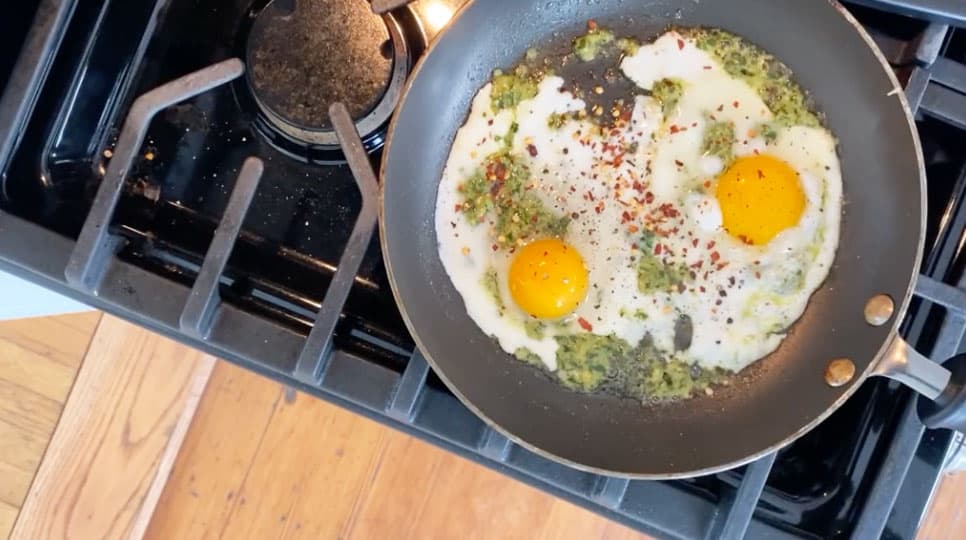
TikTok has our stomachs growling once again. And no—it's not for baked feta pasta or nature's cereal. This time it's for green eggs. Well, eggs cooked in green pesto, that is.
This mouth-watering pesto eggs trend was made popular by TikTok user Amy Wilichowski. Her video has now received more than 1.3 million likes, so of course we had to see what all the fuss was about. After watching, we've gotta say... we totally get the hype.
In the video, Wilichowski shows us how easy it is to make pesto eggs. When cooking them, you simply swap the butter or oil you'd typically use with flavor-packed pesto. So now that you know what you'll be making for breakfast tomorrow (and maybe the next day, or five), continue reading for the simple step-by-step instructions and how to go about it the eco-friendly way.
How to Make Pesto Eggs
Ingredients:
Eggs
Pesto
Slice of bread
Avocado
Instructions:
1. To cook your eggs, start out by spreading some pesto in a pan. There's no need to add any cooking oil, as the oil from the pesto will prevent any sticking.
2. Make your eggs however you'd like: scrambled, fried, or sunny-side-up.
3. If you want to jazz the dish up, you can follow Wilichowski's lead and add a spread of ricotta to a piece of toast, followed by smashed avocado.
4. Finish it off by topping the avocado toast with your pesto eggs. Add a bit of salt, pepper, honey, and red pepper flakes, and you're good to go.
How to Select a More Sustainable Egg
If you want to make this recipe a little more planet-friendly but aren't totally ready to give up traditional eggs, look for a few of these labels when picking up your next carton.
1. Cage-Free
Cage-free hens are given the freedom to walk, spread their wings, and lay their eggs in nests. The large majority of cage-free hens live on farms that are audited by a third party certification program. These programs require perching and dust bathing areas, which are very advantageous to the birds.
While cage-free isn't necessarily perfect, as there can still be some issues with animal welfare, it generally provides a significantly better habitat for the birds than caged environments.
2. Pasture-Raised
Pasture-raised is another common label to look out for. Pasture-raised hens are given at least 108 square feet each to live in vs. caged hens (which are given 67 square inches) or even cage-free hens (which get less than one square foot). These hens are typically able to enjoy the outdoors, being let out of the barn in the early morning and called to return before dark.
While conditions are likely much better than caged environments, there can still be misconduct with pasture-raised hens. This is why it's important to look for certification labels like Certified Humane, which is a certification body that ensures farms meet very strict treatment standards.
3. Organic
The word "organic" isn't necessarily indicative of the treatment of the chickens. However, it does signify that the hens received feed that did not contain unfavorable ingredients (like animal byproducts, pesticides, or synthetic fertilizers). You can look for the organic label in combination with one of the labels above to ensure a more humane option.
Vegan Egg Substitutes
Plant-based eaters can enjoy this recipe, too! You can easily swap the egg for one of the substitutes below.
1. JUST Egg
JUST Egg is a delicious plant-based alternative to traditional eggs. It contains a similar amount of protein, but has zero cholesterol and less saturated fat than your typical egg. It also requires less land, water, and carbon emissions to make.
2. Chickpea Scramble
At 39 grams of protein per cup, chickpeas make a great egg substitute. Combine chickpea flour with just a few other ingredients and you'll be left a dish that's similar in texture and taste to conventional eggs.
3. Tofu Scramble
Much like chickpeas, tofu can make for a great scrambled egg alternative. Throw in a few spices (and of course some pesto!) and you'll have a fully plant-based version of Wilichowski's delicious meal.






